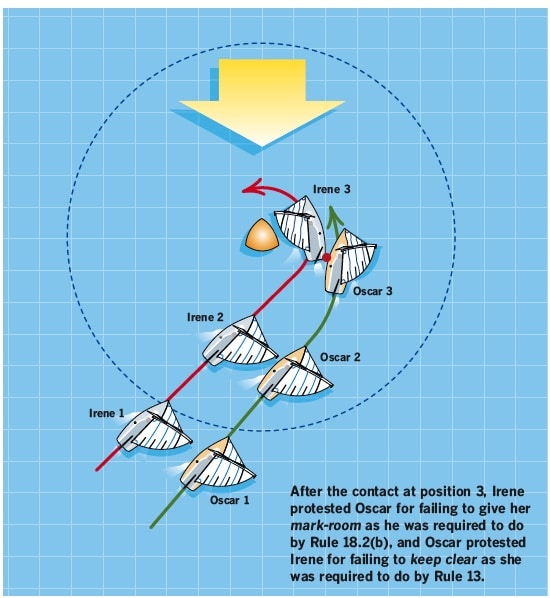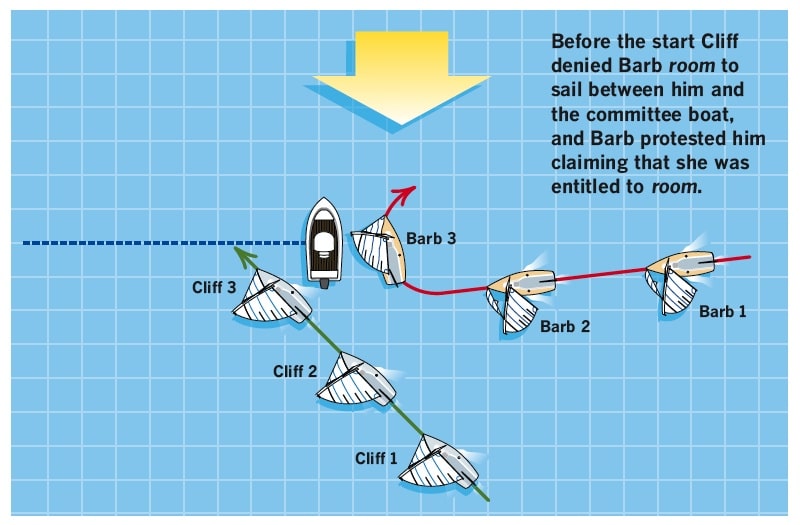The first question involves a common situation at the windward mark. As the first diagram illustrates below, Irene and Oscar were close-hauled on port tack approaching a windward mark that they were required to leave to port. They were overlapped, with Irene, the windward boat, required by Rule 11 to keep clear of Oscar, the leeward boat. When they reached the zone (position 1) they were overlapped with Irene inside Oscar, and Rule 18 began to apply between them (see Rule 18.1’s first sentence). Irene was entitled to mark-room under the first sentence of rule 18.2(b).

What was Irene entitled to? According to the definition of Mark-Room, Irene was entitled to room for three maneuvers—room “to sail to the mark,” “then room to sail her proper course while at the mark,” and “room to tack” because she was “overlapped to windward and on the inside” of Oscar. For each maneuver, Irene was entitled to the space she needed in the existing conditions to carry out the maneuver promptly in a seamanlike way (see the definition Room).
When Irene’s bow came abeam of the mark, she was no longer sailing “to the mark.” Her proper course was then to tack around the mark, and she promptly did so. As Irene tacked, Oscar, who wanted to tack as soon as Irene was out of his way, began his tack. At position 3, just after Irene passed head to wind and before Oscar luffed all the way up to head to wind, contact occurred between the starboard af corner of Irene’s transom and Oscar’s port side. There was neither damage nor injury. Each boat protested the other.
Here’s how I would’ve decided these protests. When the contact occurred, Irene had just passed head to wind and so Rule 18.2(b) no longer applied (see Rule 18.2(c)). As is often the case, the decision here depends on where the boats were a short time before the contact occurred. Rewind the movie a few frames and consider how the rules applied as Irene was heading directly into the wind. At that moment, she was still entitled to room to tack under Rule 18.2(b). Room to tack for Irene was room to make the approximately 90-degree turn from close-hauled on port tack to close-hauled on starboard. (Note that the verb “to tack” is no longer a defined term. Therefore, it has its everyday nautical meaning.) The contact between the boats occurred just after Rule 18.2(b) “switched off,” but the fact that there was contact demonstrated that, a second or so earlier while Rule 18.2(b) was still “on,” Oscar was not giving Irene either room to sail her proper course or room to tack. Therefore, Irene wins her protest and Oscar is disqualified for breaking Rule 18.2(b) just before Irene turned past head to wind.
During the short period between the time that Irene turned past head to wind and the time she completed her tack, Irene was required to keep clear of Oscar under Rule 13, and she failed to do so. Rule 13 is in Section A. Since Irene broke Rule 13 while “rounding the mark on her proper course,” she is exonerated under Rule 18.5(b). Oscar’s protest is dismissed.
The second question involved an incident between Barb and Cliff shown in the second diagram below. The committee boat was the starting mark at the starboard end of the starting line. Between the preparatory signal and the starting signal both boats were sailing toward the committee boat’s stern. They were overlapped on starboard tack, with Barb being the windward boat and Cliff the leeward boat. Barb hailed Cliff for room to pass between him and the stern of the committee boat. Cliff replied “No room!” and Barb luffed sharply, successfully avoiding both the committee boat and Cliff. Barb protested Cliff for failing to give her room.

We do not yet have enough facts to decide this protest. We need one more critical fact. At positions 1 and 2 both Cliff and Barb are approaching a starting mark surrounded by navigable water. We need to know whether Cliff and Barb were on their approach to the committee boat to start or not. The application of the rules to this incident depends dramatically on whether the boats were, or were not, on their final approach to start.
The preamble to the rules of Section C states, “Section C rules do not apply at a starting mark surrounded by navigable water . . . from the time boats are approaching [it] to start until they have passed [it].” If the boats are on their final approach to start, then Rules 18 and 19 do not apply, and we need only apply the right-of-way rules in Section A. The Section A rule that applies is Rule 11, which requires Barb to keep clear of Cliff, and she did so. So, if the boats are on their final approach to start, neither boat breaks a rule.
Now let’s assume the incident occurs just afer the preparatory signal when there are still almost 4 minutes to go before the starting signal, and that both boats intend to jibe or tack and sail away from the line one more time before turning back toward it to make their final approach to start.
If the boats are not on their final approach, Barb is not entitled to markroom under Rule 18. Rule 18 applies between boats only “when they are required to leave a mark on the same side and at least one of them is in the zone.” Rule 28.2 tells us that a boat is not required to leave a starting mark on the required side until she is “approaching the starting line from its pre-start side to start.” Therefore, the boats were not required to leave the committee boat to starboard at the time of the incident and so Rule 18 did not apply between them.
What about Rule 19? The committee boat certainly was large enough to be an obstruction (see the definition Obstruction). The obstruction was a mark, but it was not a mark that Cliff and Barb were required to leave on the same side. Therefore, Rule 19 applied (see Rule 19.1). Cliff had chosen to leave the obstruction to starboard and Barb was overlapped with him and sailing to pass between him and the obstruction. Therefore, Cliff was required by Rule 19.2(b) to give Barb “room between [him] and the obstruction.” Nothing prevented Cliff from giving Barb room, and so Cliff broke Rule 19.2(b) and should be disqualified.
How can competitors or protest committees decide when boats are on their final approach to start? There is no case or appeal that answers this question, but in my experience it’s always been obvious when boats are on the final approach, and I have never heard of a protest in which there was any dispute over whether the boats were on the final approach.









